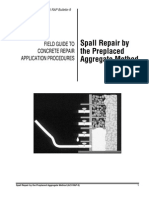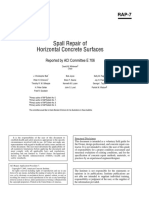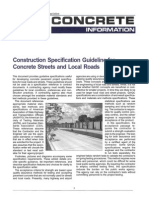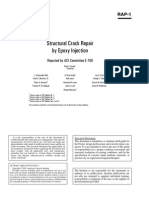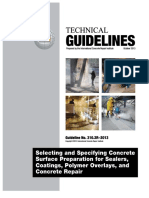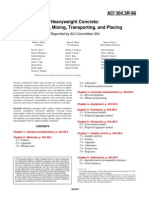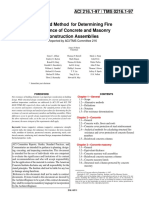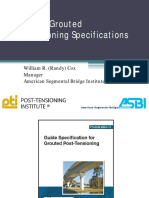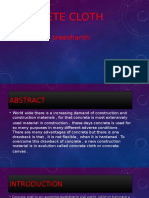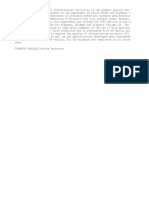100%(1)100% found this document useful (1 vote)
164 viewsRap 9 PDF
Rap 9 PDF
Uploaded by
angelCopyright:
© All Rights Reserved
Available Formats
Download as PDF, TXT or read online from Scribd
Rap 9 PDF
Rap 9 PDF
Uploaded by
angel100%(1)100% found this document useful (1 vote)
164 views7 pagesOriginal Title
RAP-9.pdf
Copyright
© © All Rights Reserved
Available Formats
PDF, TXT or read online from Scribd
Share this document
Did you find this document useful?
Is this content inappropriate?
Copyright:
© All Rights Reserved
Available Formats
Download as PDF, TXT or read online from Scribd
Download as pdf or txt
100%(1)100% found this document useful (1 vote)
164 views7 pagesRap 9 PDF
Rap 9 PDF
Uploaded by
angelCopyright:
© All Rights Reserved
Available Formats
Download as PDF, TXT or read online from Scribd
Download as pdf or txt
You are on page 1of 7
ACI RAP Bulletin 9
®
American Concrete Institute
Advancing concrete knowledge
FIELD GUIDE TO Spall Repair by
CONCRETE REPAIR the Preplaced
APPLICATION PROCEDURES Aggregate Method
Spall Repair by the Preplaced Aggregate Method (ACI RAP-9) 1
2 Repair Application Procedures Bulletin
ACI RAP Bulletin 9
(Reapproved 2010)
Field Guide to Concrete Repair Application Procedures
Spall Repair by the Preplaced Aggregate Method
Reported by ACI Committee E706
David W. Whitmore
Chair
J. Christopher Ball Fred R. Goodwin Kenneth M. Lozen Jay H. Paul
Peter H. Emmons Bob Joyce John S. Lund George I. Taylor
Timothy R. W. Gillespie Brian F. Keane Kelly M. Page Patrick M. Watson*
H. Peter Golter
*
Primary author.
It is the responsibility of the user of this document to Structural Disclaimer
establish health and safety practices appropriate to the specific
circumstances involved with its use. ACI does not make any This document is intended as a voluntary field guide for
representations with regard to health and safety issues and the use the Owner, design professional, and concrete repair con-
of this document. The user must determine the applicability of tractor. It is not intended to relieve the user of this guide
all regulatory limitations before applying the document and of responsibility for a proper condition assessment and
must comply with all applicable laws and regulations,
including but not limited to, United States Occupational structural evaluation of existing conditions, and for the
Safety and Health Administration (OSHA) health and specification of concrete repair methods, materials, or
safety standards. practices by an experienced engineer/designer.
ACI Repair Application Procedure 9.
Copyright © 2005, American Concrete Institute.
All rights reserved including rights of reproduction and use in any The Institute is not responsible for the statements or
form or by any means, including the making of copies by any photo pro- opinions in its publications. Institute publications are
cess, or by electronic or mechanical device, printed, written, or oral, or
recording for sound or visual reproduction or for use in any knowledge not able nor intended to supplant individual training,
retrieval system or device, unless permission in writing is obtained from responsibility or judgment of the user, or the supplier of
the copyright proprietors. Printed in the United States of America. the information provided.
Spall Repair by the Preplaced Aggregate Method (ACI RAP-9) 3
Introduction
Preplaced-aggregate concrete (PPA) is defined as
“Concrete produced by placing coarse aggregate in a form
and later injecting portland cement-sand grout, usually with
admixtures, to fill the voids.” ACI 304.1R-92, “Guide for the
Use of Preplaced Aggregate Concrete,” provides informa-
tion for job-site mixing of grout for PPA. There are also
proprietary products available for grouting preplaced-aggre-
gate concrete. Today, most preplaced-aggregate concrete is
produced with prepackaged grouts made specifically for use
with PPA.
Placing the aggregate first has several benefits:
• Point-to-point contact of large aggregate is optimized;
Fig. 1—Preparation
• Uniform aggregate distribution and density are achieved;
• The ratio of aggregate-to-cement paste is higher than in This method of repair can have higher labor costs than
placeable concrete; cast-in-place concrete but has proven to be effective where
• Aggregate can be placed in hard-to-get-at locations shrinkage of the repair cannot be allowed.
such as around closely spaced reinforcing steel; and
• Shrinkage is reduced by 50 to 100% compared to How do I prepare the surface?
typical cast-in-place concrete. Consult the recommendations of International Concrete
Before any concrete repair is carried out, assess the root cause Repair Institute (ICRI) Guideline No. 310.2-1997, “Selecting
of the damage so the objective of the repair is understood. and Specifying Concrete Surface Preparation for Sealers, Coat-
ings, and Polymer Overlays,” or No. 310.1R-2008, “Guide to
Typical causes of concrete damage include steel corrosion,
Surface Preparation for Repair of Deteriorated Concrete
sulfate attack, freezing-and-thawing damage, and alkali-
Resulting from Reinforcing Steel Corrosion.” Also, consult
aggregate reactions (AARs). Excessive shrinkage of the
the manufacturer of any prepackaged grout to be used.
original concrete and/or settlement in the structure may be a
cause of damage. Improper joint spacing and load imbal- Factors that will influence surface preparation for the
ances also contribute to cracking and spalling. specific application include, but are not limited to:
• Desired roughness profile of the prepared surface;
What is the purpose of this repair? • The method of preparation, such as: hydrodemolition,
Preplaced-aggregate concrete is used for repairs to restore sandblasting, use of pneumatic hammers, and shot-
structural integrity, provide extra cover, reduce the potential blasting;
for shrinkage-related repair failures, and for underwater • Possible contamination of the surface by oils or soaps, or
repair, particularly when cofferdams are impractical. surface carbonation—both of which require additional
preparatory steps. These may include pressure washing,
When do I use this method? hot-water pressure washing, cleaning with degreasing
Preplaced-aggregate concrete is most often used for detergents, and chemical extraction methods;
vertical, overhead, and underwater repairs. It can be used for • Requirements for saturation of concrete in the area to
horizontal repairs. PPA is often chosen when repairs require be repaired;
getting concrete into tight or hard-to-reach areas. The appli- • Reinforcing requirements by the engineer or owner;
cations can be structural or cosmetic. Successful applications • Treatment of existing cracks and joints in the substrate;
have included dam faces, spillways, bullnoses, and bridge and
columns and footings. Many of these applications have • Repair the cracks? How? Fill the joints? If so, how and
required that repairs be completed under water and some- with what?
times in moving water. Surface preparation is similar to that for most concrete
This method has been particularly successful for jacketing repairs. With the above considerations in mind, concrete is
columns. removed until acceptable-quality concrete is located and
The preplaced aggregate method can be used for most revealed. Reinforcing steel, if exposed, is undercut, and all
repair applications that call for a thickness or depth greater exposed surfaces are cleaned with high-pressure water
than 2 in. (50 mm). An experienced contractor working (minimum 3000 psi) or are abrasively blasted. With PPA
under the guidance of a qualified engineer is the best choice repairs, consideration should be given to how the grout will
for repairs using this method. be pumped into the forms and through the aggregate from the
Forming is very similar to that used for cast-in-place bottom up (refer to ACI 304.1R).
concrete. The forms must be watertight. The selection and
preparation of materials also require careful attention to How do I select the right materials?
detail (see the “Repair procedure” and “How do I select the Use sound, tested, properly graded aggregate. Test aggre-
correct materials?” sections). gate for reactivity in accordance with ASTM C 1260. Grade
4 Repair Application Procedures Bulletin
the aggregate in accordance with the recommendations of • A sprayer, rollers, or brushes if a curing compound is
Table 1 of ACI 304.1R. Rewash the aggregate. required.
Considerations in grout selection include:
• The traditional material used for PPA grout has been What are the safety considerations?
site-mixed sand-cement with the addition of grout Safety considerations include but are not limited to:
fluidifiers and aluminum powder. These materials can Portland cement-based materials are alkaline and abrasive,
be difficult to control and keep consistent under field and should be treated as such. Job-site safety practices
conditions. Control of expansion and bleeding are very should include:
difficult. Prepackaged products made specifically for • Having Material Safety Data Sheets for products on site
use in preplaced-aggregate concrete should provide and reviewing them before startup;
greater consistency and control; • Having correct safety guards, maintenance, and warnings
• Grouts with pretested freezing-and-thawing resistance in place for all machinery and equipment to be used;
should be used where repairs will be exposed to • Having all workers wearing protective eyewear, safety
freezing-and-thawing cycles; glasses, or face shields;
• Grouts with corrosion-inhibiting admixtures should be • Having all workers in contact with wet cementitious
considered where corrosion of reinforcing steel is a factor; material wearing protective gloves (rubber- or
• Very low or no bleeding of the fluid grout is necessary neoprene-coated) and clothing;
to ensure quality repair with PPA; Bond characteristics • Having eyewash facilities available on site;
for grout should be tested in accordance with ACI 503R • Providing dust masks for workers operating material
Appendix A; see ICRI Technical Guideline 03739, mixers;
“Guide to Using In-Situ Tensile Pull-Off Test to Eval- • Confirming that adequate ventilation is available in
uate Bond of Concrete Surface Materials.” closed spaces before operating equipment or using
• Test compressive strength of grouts in accordance with products that emit dangerous exhaust, fumes, or dust;
ASTM C 942;
• Having secured storage available for all hazardous or
• Make all tests on grout mixed to flow consistency to be
flammable materials; and
used in repair; and
• Holding a safety meeting for all involved parties, lead
• Test compressive strength of the grout and aggregate
by the prime contractor’s safety manager, prior to
combination in accordance with ASTM C 943. This is a
beginning repair operations.
special method of testing. Be sure to consult with the
It is the responsibility of the user of this document to
testing laboratory and engineer to ensure that proper
establish health and safety practices appropriate to the
test equipment is on-site and technicians are trained in
specific circumstances involved with its use. ACI does not
the procedure.
make any representations with regard to health and safety
issues and the use of this document. The user must determine
What equipment do I need?
• Test equipment, if not provided by an independent labo- the applicability of all regulatory limitations before applying
ratory: Flow cone in accordance with ASTM C 939 and the document and must comply with all applicable laws and
PPA test cylinders in accordance with ASTM C 943; regulations, including but not limited to, United States Occu-
• Placement equipment: Water meter or water measuring pational Safety and Health Administration (OSHA) health
device; and safety standards.
• pH indicator such as phenolphthalein;
• Concrete or grout pump (not ball valve type): Short- Preconstruction meeting
Prior to proceeding with the repair, a preconstruction
stroke, swing-type piston pumps or heavy-duty rotor-
meeting is recommended. The meeting should include repre-
stator pumps perform well. If using a rotor-stator or
sentatives from all participating parties (owner, engineer,
“moyno”-type pump, have a backup rotor on hand at
contractor, materials manufacturer, etc.), and specifically
the job site;
address the parameters, means, methods, and materials
• Grout mixers, if not built into pump: Use tub-type vertical
necessary to achieve the repair objectives.
shaft mixers or horizontal shaft mortar mixers with rubber
blade wipers. (Do not use portable concrete mixers with a Include the owner’s representative, the specifier, the
rotary drum.) Have a backup mixer available in case of project manager, the repair grout manufacturer, and the
breakdown. Some specialty concrete/grout pumps construction team foreman. See ICRI Guideline No. 03733,
come equipped with mixers and water meters; “Guide to Selecting and Specifying Materials for Repair of
• For large projects, grout can be batched into ready-mix Concrete Surfaces,” for additional agenda items.
concrete transit mixer trucks, or prepackaged grout is The preconstruction meeting list or agenda might include:
available in bulk bags up to 3300 lb (1500 kg) each; • On-site availability of power;
• A sieve of adequate size for on-site grading of aggre- • On-site availability of mixing water;
gate if a pre-graded supply is not available; • Site accessibility;
• A method of rewashing sieved-graded aggregate. This • Debris removal and disposal;
may be a second sieve with washout hoses and agitator; • Dust, odor, and emissions control;
• Connector valves or shutoffs for grout inlet pipes; and • Control of water runoff;
Spall Repair by the Preplaced Aggregate Method (ACI RAP-9) 5
Fig. 2—Forming Fig. 4—Pumping grout
E. Saturate the aggregate
Saturate the aggregate to prevent rapid absorption of water
from the grout and thickening of the grout as it flows.
F. Place clean/saturated aggregate as the forms are
erected.
Do not drop aggregate more than 5 ft (1.5 m) except where
repairs are under water and aggregate will fall through water.
Place grout pipes and observation tubes if required (see
ACI 304.1R for suggestions concerning placement of grout
pipes and observation tubes).
Inlet pipe placement will vary depending on the repair
configuration.
Fig. 3—Aggregate placement
G. Batch the grout.
Typical mixing equipment for mixing grout is a two-tub
• Confirmation that all materials and equipment are mixer equipped with a rotor-stator pump and a water meter.
available. Pay particular attention to required quantities These pumps are commercially available from several grout
of grout and graded, washed aggregate; pump manufacturers. Do not use ball-valve pumps.
• Confirmation that all material documentation is on site; Have adequate mixing and pumping equipment on hand.
for example, MSDS information; This usually means at least one backup unit.
• Noise control; If using prepackaged grout, consult the manufacturer for
• Methods of curing and time required for curing; mixing recommendations.
• Responsibility for quality control and final acceptance; Check the grout consistency. Grout should be tested in
• Possible emergencies and breakdowns—what to do if accordance with ASTM C 939. This is the flow cone test for
they occur; and consistency. A flow of 10 to 30 s is typical for site-made
• All other concerns that could affect the progress of the grouts; prepackaged grouts should have flow values as
repair. recommended by the manufacturer.
H. Pump and place the grout.
Repair procedure Provide a means of communication between mixer/ pump
1. Install the repair.
operator and placement crew.
A. Inspect and approve the surface preparation.
Check surface for contamination. Connect pump hose to grout inlet openings or pipes.
B. Saturate the prepared surface if required. Start placement at bottom of aggregate placement.
C. Set forms grout-tight. External form vibration will aid in grout consolidation. It
Commonly used grout-head pressure number is 10 psi is not always necessary with well-graded aggregates and
(70 kPa). good quality grout.
When form joints do not match perfectly, seal them When forms appear full, keep light pressure on from pump
from the inside with adhesive tape. for several minutes to prevent sagging and displace water/air
Where forms fit against original concrete, seal with thick from forms. Stop if grout is spilling out of forms.
mortar, strong compressible material, or caulking rope. 2. Finish the repair.
Avoid the use of caulks as they may yield under head pres- Confirm what the final finished appearance of the repair is
sure from the grout. to be at the open areas of the forms.
D. Grade the aggregate. If vertical formed repairs with open tops are used, work
PPA requires gap-graded aggregate. This can be provided small aggregate (3/8 or 3/4 in. [10 or 20 mm]) into the
as specified in ACI 304.1R, by a supplier, or sieved on site. surface. Finish as required.
6 Repair Application Procedures Bulletin
Cure PPA in the same manner as conventional concrete, ACI Committee 308, 2001, “Guide to Curing Concrete (ACI 308R-01),”
per ACI 308R. American Concrete Institute, Farmington Hills, MI, 31 pp.
ACI Committee 503, 1993, “Use of Epoxy Compounds with Concrete
(ACI 503R-93),” American Concrete Institute, Farmington Hills, MI,
How do I check the repair? Appendix A.
Typical procedures could include: ACI Committee 546, 2004, “Concrete Repair Guide (ACI 546R-04),”
American Concrete Institute, Farmington Hills, MI, 53 pp.
• Document the project before, during, and after with ASTM C939-10, 2010, “Standard Test Method for Flow of Grout for
photos; Preplaced Aggregate Concrete (Flow Cone Method),” ASTM International,
West Conshohocken, PA, 3 pp.
• Pre-confirm the acceptability of the prepared surface,
ASTM C942-10, 2010, “Standard Test Method for the Compressive
including any pH requirements, and the specified Strength of Grouts for Preplaced-Aggregate Concrete in the Laboratory,”
surface profile; ASTM International, West Conshohocken, PA, 3 pp.
• Have all materials pre-tested by a qualified test laboratory ASTM C943-10, 2010, “Standard Practice for Making Test Cylinders
and Prisms for Determining Strength and Density of Preplaced-Aggregate
for compliance with manufacturers’ stated properties; Concrete in the Laboratory,” ASTM International, West Conshohocken,
• Perform in-place tensile pulloff tests of the prepared PA, 4 pp.
substrate surface; Confirm the quality of bond of the ASTM C1260-07, 2007, “Standard Test Method for Potential Alkali
Reactivity of Aggregates (Mortar-Bar Method),” ASTM International,
completed repair by direct tensile bond test (ACI 503R West Conshohocken, PA, 5 pp.
Appendix A, see “ICRI Technical Guideline 03739, International Concrete Repair Institute, 1997, “Selecting and Specifying
Guide to Using In-Situ Tensile Pull-Off Test to Eval- Concrete Surface Preparation for Sealers, Coatings, and Polymer Over-
uate Bond of Concrete Surface Materials.”); and lays,” Technical Guideline No. 310.2-1997, 41 pp.
International Concrete Repair Institute, 2004, “Guide for Using In-Situ
• Confirm that all materials used were as specified, cross Tensile Pull-Off Tests to Evaluate Bond of Concrete Surface Materials,”
check material purchase orders with quantities estimated Technical Guideline No. 210.3-2004, 16 pp.
and with actual quantities billed. International Concrete Repair Institute, 2008, “Guide for Surface Prepa-
ration for the Repair of Deteriorated Concrete Resulting from Reinforcing
Steel Corrosion,” Technical Guideline No. 310.1R-2008, 12 pp.
Sources for additional information King, J., and Bush, E., 1960, “Grouting of Granular Materials,” ASCE
ACI Committee 304, 1992, “Guide for the Use of Preplaced Aggregate Convention.
Concrete for Structural and Mass Concrete Applications (ACI 304.1R- King, J., and Wilson, A., 1988, “If It’s Still Standing, It Can Be
92),” American Concrete Institute, Farmington Hills, MI, 19 pp. Repaired,” Concrete Construction, July.
Spall Repair by the Preplaced Aggregate Method (ACI RAP-9) 7
You might also like
- ICRI - Guide For Surface Preparation For The Repair of Deteriorated Concrete Resulting From Reinforcing Steel Corrosion 2008 (2016!05!03)Document16 pagesICRI - Guide For Surface Preparation For The Repair of Deteriorated Concrete Resulting From Reinforcing Steel Corrosion 2008 (2016!05!03)Matt100% (9)
- E178Document18 pagesE178angel0% (1)
- 544 4R-182 PDFDocument45 pages544 4R-182 PDFangel0% (3)
- ACI 546.1R-80, Guide For Repair of Concrete Bridge SuperstructuresDocument20 pagesACI 546.1R-80, Guide For Repair of Concrete Bridge SuperstructuresماقوريNo ratings yet
- 503 6R-97 PDFDocument4 pages503 6R-97 PDFsaeidcivil89No ratings yet
- Rap 14 PDFDocument7 pagesRap 14 PDFangelNo ratings yet
- ACI RAP-4 - Surface Repair Using Form-and-Pour Techniques - 2011Document8 pagesACI RAP-4 - Surface Repair Using Form-and-Pour Techniques - 2011ilo88No ratings yet
- Icri 710-2-2014Document22 pagesIcri 710-2-2014jabh311100% (2)
- Hot Weather Concreting CTIFDocument5 pagesHot Weather Concreting CTIFGang GaNo ratings yet
- ACI 201.1R Guide To Conducting A Visual Inspection of Concrete in ServiceDocument19 pagesACI 201.1R Guide To Conducting A Visual Inspection of Concrete in ServiceRenato Rocha100% (1)
- Aci 207.1R-96Document45 pagesAci 207.1R-96hasan_676489616100% (2)
- ACI Manual of Concrete Inspection PDFDocument1 pageACI Manual of Concrete Inspection PDFSushil Dhungana33% (3)
- Icri 310-2R-2013Document55 pagesIcri 310-2R-2013joel_garcia_112100% (3)
- Rap 14 PDFDocument7 pagesRap 14 PDFangelNo ratings yet
- State-Of-The-Art Report On Fiber Reinforced Concrete ACI 544-2002Document66 pagesState-Of-The-Art Report On Fiber Reinforced Concrete ACI 544-2002Attie761367% (3)
- Demolition Method StatementDocument33 pagesDemolition Method Statementgeorge israel50% (2)
- Method Statement For Plunge ColumnDocument17 pagesMethod Statement For Plunge Columnvikas100% (3)
- Slabjacking: Field Guide To Concrete Repair Application ProceduresDocument7 pagesSlabjacking: Field Guide To Concrete Repair Application ProceduresangelNo ratings yet
- Surface Repair Using Form-and-Pour Techniques: Reported by ACI Committee E 706Document7 pagesSurface Repair Using Form-and-Pour Techniques: Reported by ACI Committee E 706Carlos Gonzalez100% (1)
- Surface Repair Using Form-and-Pump Techniques: Field Guide To Concrete Repair Application ProceduresDocument8 pagesSurface Repair Using Form-and-Pump Techniques: Field Guide To Concrete Repair Application ProcedurescustomerxNo ratings yet
- Rap 2Document5 pagesRap 2mkhibosNo ratings yet
- Guide For Selecting Application Methods For The Repair of Concrete SurfacesDocument8 pagesGuide For Selecting Application Methods For The Repair of Concrete SurfacesMauricio Javier León Tejada100% (1)
- ACI RAP-7 Spall Repair of Horizontal Concrete SurfacesDocument7 pagesACI RAP-7 Spall Repair of Horizontal Concrete SurfacesGeorgie MachaNo ratings yet
- Methacrylate Flood Coat: Field Guide To Concrete Repair Application ProceduresDocument6 pagesMethacrylate Flood Coat: Field Guide To Concrete Repair Application ProceduresangelNo ratings yet
- ACI - Shotcrte para ReparaciónDocument6 pagesACI - Shotcrte para ReparaciónJimy Mejia MendozaNo ratings yet
- Vertical and Overhead Spall Repair by Hand ApplicationDocument7 pagesVertical and Overhead Spall Repair by Hand Applicationshadab521No ratings yet
- Field Guide To Concrete Repair Application Procedures: RAP Bulletin 3-21Document8 pagesField Guide To Concrete Repair Application Procedures: RAP Bulletin 3-21EMILIO MINORU TAKAGI100% (1)
- Spall Repair by The Preplaced Aggregate Method: Field Guide To Concrete Repair Application ProceduresDocument7 pagesSpall Repair by The Preplaced Aggregate Method: Field Guide To Concrete Repair Application ProcedurescustomerxNo ratings yet
- ACI RAP-2 - Crack Repair by Gravity Feed With Resin - 2011 PDFDocument6 pagesACI RAP-2 - Crack Repair by Gravity Feed With Resin - 2011 PDFilo88100% (1)
- C878C878M 14aDocument5 pagesC878C878M 14aJamman Shahid ShiblyNo ratings yet
- ACI E-706 Spall Repair of Horizontal Concrete SurfacesDocument6 pagesACI E-706 Spall Repair of Horizontal Concrete SurfacesmirzaNo ratings yet
- Determining F Floor Flatness and F Floor Levelness Numbers: Standard Test Method ForDocument8 pagesDetermining F Floor Flatness and F Floor Levelness Numbers: Standard Test Method Forrenzo_macherNo ratings yet
- Construction Specification Guideline For Concrete Streets and Local Roads IS119P 4Document24 pagesConstruction Specification Guideline For Concrete Streets and Local Roads IS119P 4wickremasingheNo ratings yet
- MasterPozzolith 384 Technical Data SheetDocument3 pagesMasterPozzolith 384 Technical Data Sheetabukayes.abdinNo ratings yet
- Aci Rap-1Document7 pagesAci Rap-1Mauricio De Stefani100% (1)
- ACI Crack RepairDocument6 pagesACI Crack RepairelmerbarrerasNo ratings yet
- Repair Application ProceduresDocument6 pagesRepair Application ProceduresSatheesh Rama SamyNo ratings yet
- Bond Strength of Shotcrete Repair PDFDocument4 pagesBond Strength of Shotcrete Repair PDFchutton681No ratings yet
- 2017 Pub Catalog PublishWEBDocument14 pages2017 Pub Catalog PublishWEBJohn PinkNo ratings yet
- Icri 310Document54 pagesIcri 310Romilson De Andrade100% (1)
- 5064r - 94 Guide For The Evaluation of ShotcreteDocument16 pages5064r - 94 Guide For The Evaluation of ShotcreteLucas NascimentoNo ratings yet
- Masonry Tutorial Spanish BlondetDocument14 pagesMasonry Tutorial Spanish BlondetStevens NinanyaNo ratings yet
- 320 3R-2012 PDFDocument13 pages320 3R-2012 PDFJorge Andrés100% (1)
- Concrete RepairDocument7 pagesConcrete RepairjjahaddinNo ratings yet
- C1116-C1116M - 10aDocument7 pagesC1116-C1116M - 10aElder SantosNo ratings yet
- Aci 304.3R-96Document8 pagesAci 304.3R-96minhnnNo ratings yet
- 2161 - 97 RC and Masonry Fire ResistanceDocument26 pages2161 - 97 RC and Masonry Fire Resistanceanon_434029895No ratings yet
- Concrete Repair & Restoration (Sika)Document37 pagesConcrete Repair & Restoration (Sika)Dinn Ns100% (2)
- Pages From Concrete Repair and Maintenance Illustrated, PH Emmons PDFDocument3 pagesPages From Concrete Repair and Maintenance Illustrated, PH Emmons PDFCurtis DookieNo ratings yet
- DSI ALWAG Systems IBO Self Drilling Anchor eDocument8 pagesDSI ALWAG Systems IBO Self Drilling Anchor eMarco Dos Santos NevesNo ratings yet
- Aci 232Document34 pagesAci 232Anggoro SenoNo ratings yet
- ACI 325.10R-95: Reported by ACI Committee 325Document32 pagesACI 325.10R-95: Reported by ACI Committee 325edgomurNo ratings yet
- ASBI Grouted Post Tensioning SpecificationsDocument19 pagesASBI Grouted Post Tensioning Specificationselev lookNo ratings yet
- Masterflow 928 Spec PDFDocument8 pagesMasterflow 928 Spec PDFDavid Toyohashi BioGenNo ratings yet
- 524r 16 PreviewDocument4 pages524r 16 Previewosama anterNo ratings yet
- Crack Repair by Gravity Feed With ResinDocument6 pagesCrack Repair by Gravity Feed With ResinEladio Almengor100% (1)
- Guia de Reparacion PACDocument7 pagesGuia de Reparacion PACjose alfredo rodriguez medinaNo ratings yet
- Aci Rap 12Document6 pagesAci Rap 12Miguel Agustin Ponce LozoyaNo ratings yet
- Rap 7Document7 pagesRap 7Vladimir AliendreNo ratings yet
- Section 3-5 Paper 5 ACI RAP 4Document8 pagesSection 3-5 Paper 5 ACI RAP 4Juan Pablo Santamaria V.No ratings yet
- Concrete Crack Repair PDFDocument6 pagesConcrete Crack Repair PDFNawshad KhNo ratings yet
- Concrete Dam Repair Tech PDFDocument32 pagesConcrete Dam Repair Tech PDFVitthal AwtadeNo ratings yet
- Cocrete RepairDocument2 pagesCocrete RepairAlex MajorNo ratings yet
- Rap 6Document8 pagesRap 6nimalranasinghe2505100% (1)
- RAP Bulletin 1 - Stractural Crack Repair by Epoxy InjectionDocument26 pagesRAP Bulletin 1 - Stractural Crack Repair by Epoxy InjectionamroNo ratings yet
- Installation of Embedded Galvanic Anodes: Field Guide To Concrete Repair Application ProceduresDocument7 pagesInstallation of Embedded Galvanic Anodes: Field Guide To Concrete Repair Application ProceduresماقوريNo ratings yet
- Methacrylate Flood Coat: Field Guide To Concrete Repair Application ProceduresDocument6 pagesMethacrylate Flood Coat: Field Guide To Concrete Repair Application ProceduresangelNo ratings yet
- 544 4R-182 PDFDocument45 pages544 4R-182 PDFangel17% (6)
- 308R 16 PDFDocument41 pages308R 16 PDFangel0% (1)
- Should Minimum Cementitious Contents For Concrete Be Specified?Document8 pagesShould Minimum Cementitious Contents For Concrete Be Specified?angelNo ratings yet
- ACI 308 Main Fall 2018 Las Vegas AgendaDocument2 pagesACI 308 Main Fall 2018 Las Vegas AgendaangelNo ratings yet
- 7 Chapter-III-RDocument37 pages7 Chapter-III-RRiot AyaseNo ratings yet
- PROJECTDocument82 pagesPROJECTWuod ElizaNo ratings yet
- Modification of Local Asphalt With Epoxy Resin To Be Used in PavementDocument9 pagesModification of Local Asphalt With Epoxy Resin To Be Used in Pavementsofian juniardiNo ratings yet
- Tekla Structural Designer 2021 Engineers Handbooks 0Document648 pagesTekla Structural Designer 2021 Engineers Handbooks 0wisnu666No ratings yet
- Construction of Fence Wall - HargysaDocument1 pageConstruction of Fence Wall - HargysaMohamed FarahNo ratings yet
- Precast Concrete Stairs Specification 3-22-11Document8 pagesPrecast Concrete Stairs Specification 3-22-11pravin100% (1)
- Concrete ClothDocument20 pagesConcrete ClothShrinivasNo ratings yet
- Lab Sheet ConcreteDocument5 pagesLab Sheet ConcreteAbdul nurNo ratings yet
- 270 - MegaFlow SP103Document2 pages270 - MegaFlow SP103Naeem Saleem100% (1)
- MRTS04Document43 pagesMRTS04JhinNo ratings yet
- ED-2016 Be It Small Be It Big, Nihar Kanta Nayak, Emp CD 306630Document19 pagesED-2016 Be It Small Be It Big, Nihar Kanta Nayak, Emp CD 306630nihar nayakNo ratings yet
- Catalog Sonnen MetalDocument16 pagesCatalog Sonnen MetalmabuhamdNo ratings yet
- Premix SRC-2: Ready Mixed Rush Coat For Fair Faced ConcreteDocument2 pagesPremix SRC-2: Ready Mixed Rush Coat For Fair Faced Concretesk mukhtarNo ratings yet
- Strongcoat 400 - TDSDocument4 pagesStrongcoat 400 - TDSOsama Abu ShalthamNo ratings yet
- Structural Design Specifications Preamble.Document3 pagesStructural Design Specifications Preamble.Jerry MsechuNo ratings yet
- Concrete Compression MachineryDocument9 pagesConcrete Compression MachineryChristopher ChrisNo ratings yet
- Concrete Is A StoneDocument3 pagesConcrete Is A StoneDidNo ratings yet
- Structural Design of Taipei 101, The World's Tallest BuildingDocument9 pagesStructural Design of Taipei 101, The World's Tallest BuildingSneha PeriwalNo ratings yet
- Chapter 1Document57 pagesChapter 1Oromo Oromiya EtiophiaNo ratings yet
- DPWH Blue BookDocument443 pagesDPWH Blue Book'Julius OrpiaNo ratings yet
- An Analysis On Allowable Settlements of Structures: G, Ricceri, M. SoranzoDocument13 pagesAn Analysis On Allowable Settlements of Structures: G, Ricceri, M. SoranzoJavier JiménezNo ratings yet
- 5.1 s2.0 S095006182032657X MainDocument15 pages5.1 s2.0 S095006182032657X MainAnshuman BeheraNo ratings yet
- Aci Method of Mix Design: Design Stipulation (To Be Given)Document12 pagesAci Method of Mix Design: Design Stipulation (To Be Given)Prem KumarNo ratings yet
- History of Prestressed ConcreteDocument125 pagesHistory of Prestressed Concreteuady89% (9)
- M07 Internal & External PlasteringDocument64 pagesM07 Internal & External Plasteringአለማየሁ ደመላሽ አዲሴNo ratings yet
- Materials Testing Technology: Prepared byDocument115 pagesMaterials Testing Technology: Prepared byPaolo NabosNo ratings yet
- Civil SOQ of Admin.Document146 pagesCivil SOQ of Admin.Anurag SharmaNo ratings yet
- ASTM C-1306 - Standard Method For Hydrostatic Pressure Resistance of A Liquid-Applied Waterproofing Membrane PDFDocument3 pagesASTM C-1306 - Standard Method For Hydrostatic Pressure Resistance of A Liquid-Applied Waterproofing Membrane PDFLeonardo Otto CoutinhoNo ratings yet


























